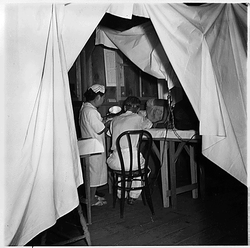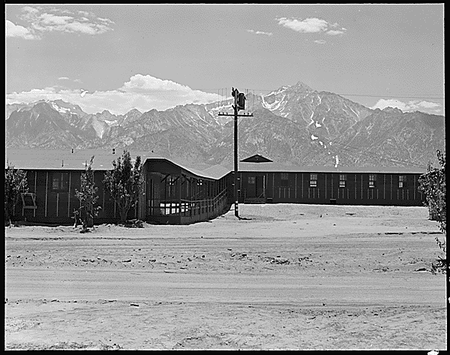Read Part 1 >>
I would like to enter one final comment about the intrinsic merit of Toshiko Eto Nakamura’s manuscript before changing gears to consider its social value. It can be plausibly argued that the memoir is too narrowly focused in its chronological scope. To be sure, the author does bound her manuscript temporally within the bookends of December 7, 1941, when the news of Japan’s bombing of Pearl Harbor precipitated a punitive public policy and attitude toward Japanese Americans, and March 26, 1943, when she bids farewell to the barbed-wire world of Manzanar to embrace the life of a “free” American in Madison, Wisconsin.
It is also true that in so framing her memoir, she eliminates any attention both to the prewar causes and the postwar consequences of the Nikkei’s World War II exclusion and detention experience. But critics who take this tack need to be mindful of two important considerations.
First, the memoir was written only a year or two after the closing in March 1946 of the last of the War Relocation Center-administered camps, that of the Tule Lake Segregation Center in northern California. At this point in time, the prewar causes were not very clearly understood, while the postwar consequences were barely unfolding.
Second, since the author apparently wrote her memoir with an eye toward publication, the already scant chance of having this objective realized would have been exponentially lessened had the manuscript emphasized the persisting historical theme of American racism, especially given that its author shared the ancestry of a reviled enemy nation very recently vanquished by the United States in a popular war.
Chances are, however, that Toshiko Eto Nakamura’s decision to restrict the temporal boundaries of her memoir to the period bracketed by Pearl Harbor and her departure from Manzanar was driven by strictly literary considerations. To begin with, her ostensible purpose was to write an autobiographical memoir about her personal World War II odyssey as a Japanese American, not a comprehensive history of the Japanese American experience in the United States, in which the Nikkei’s World War II eviction and incarceration represented but an expressive moment or defining event. Given this objective, it would make sense for her to strive for thematic unity and coherence in her memoir, which she did by dramatically juxtaposing her prewar security, freedom, and sense of normality in San Luis Obispo, California, and her postwar promise of experiencing them once again in Madison, Wisconsin, with the wartime condition of insecurity, imprisonment, and abnormality she faced during “voluntary” resettlement in eastern California and confinement in Manzanar.
It is this very juxtaposition by Toshiko Eto Nakamura that imparts to her memoir its deepest meaning, one which is reverberated in incidents recounted by her that may at first blush strike readers as being accorded disproportionate or inappropriate attention. Two of the best illustrations are found, appropriately enough, in the section of the memoir covering her incarceration in Manzanar.
The first revolves around an opportunity she had, along with five other young women hospital workers, to go horseback riding a short distance outside of the camp: “We formed a single line… Somehow, I fell in last, and so was able to view the girls from behind. A peculiar thrill ran up my spine―what an unexpected recreation. What a picture―the girls riding along in this desert waste land so happy and carefree… It was such a wonderful experience, and we certainly enjoyed ourselves. This was something very special indeed.”
The second incident, occurring some weeks later, involved a hike to and a picnic within the Sierra Madre range capped by majestic Mt. Williamson, located behind the Manzanar site: “Once we reached the top, we came to view the most gorgeous lake below. The beautiful, sequestered sight between the mountain peaks was so peaceful and quiet… My, how good those sandwiches tasted. We ate, made snowmen, and threw snowballs at each other. We even spotted a deer teasingly strolling away. This excursion was especially memorable because we realized how privileged we were to receive permission to go out of the camp in such a large group.”
But what of the social value of Toshiko Eto Nakamura’s manuscript and, by extension, its current incarnation as Nurse of Manzanar? An historian colleague of mine always makes a point in her course syllabi of explaining her biographical orientation to the study of history: “Since history focused on large events rather than people is, in a word, boring, we will spend as much time as possible in this class looking at events through the experience of real human beings.”
There is, of course, a general social value to not boring people. But this prescription carries special salience in the context of a democracy, where a premium is placed on active and widespread public participation by the citizenry in the process of governance. Consistent with this notion, it is important that the historical education given to Americans enlivens them to the past rather than deadening them to it, for only when a society knows where it has been can it properly ascertain where it wants and needs to go in its future development.
This is where books like Nurse of Manzanar are invaluable. On the one hand, by focusing on the experience of one particularly sensitive and caring victim among the 120,000 Japanese Americans who were wrongly mistreated by the U.S. government and the American people during World War II, this memoir serves as a compelling reminder that, although this gross mistreatment was promulgated on a corporate basis, it was experienced by specific individuals, families, and communities. On the other hand, Nurse of Manzanar acts as a catalyst for the social construction of a social order in this country that enshrines and embodies the principles of diversity, civil liberties, and social justice, by permitting us to vicariously experience a major historical event in the not-too-distant past when, with drastic consequences, these principles were honored more in the breach than in the practice.
* This article was originally published as the Foreword for Nurse of Manzanar: A Japanese American’s World War II Journey by Samuel Nakamura in 2009.
© 2009 Art Hansen







